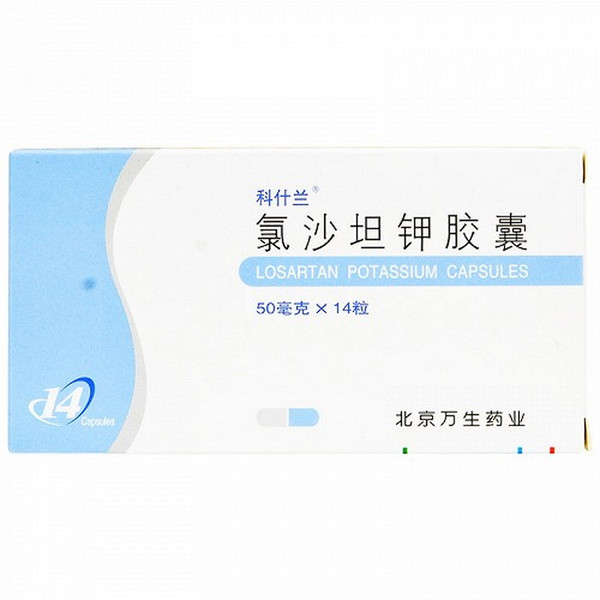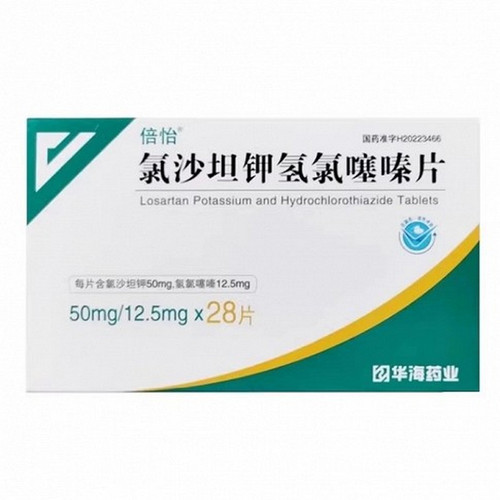Product Overview
[Drug Name]
Generic Name: Losartan Potassium Capsules
Trade Name: Koshlan
English Name: Losartan Potassium Capsules
Chinese Pinyin: Lushatanjia Jiaonang
[Ingredients]
The main ingredient of this product is losartan potassium. Chemical Name: 2-Butyl-4-chloro-1-[[2'-(1H-tetrazol-5-yl)[1,1'-biphenyl]-4-yl]methyl]-1H-imidazole-5-methanol monopotassium salt. Chemical Structure: Molecular Formula: C22H22ClKN6O Molecular Weight: 461.01
[Properties]
This product contains a white or off-white granular powder.
[Indications]
This product is indicated for the treatment of hypertension.
[Dosage and Administration]
For most patients, the usual starting and maintenance dose is 50 mg once daily. Maximum blood pressure lowering effect is achieved after 3 to 6 weeks of treatment. In some patients, increasing the dose to 100 mg once daily may produce further blood pressure lowering effects. For patients with volume depletion (e.g., those receiving high-dose diuretics), a starting dose of 25 mg once daily should be considered (see Precautions). No starting dose adjustment is necessary for elderly patients or patients with renal impairment, including those undergoing hemodialysis. A lower dose should be considered for patients with a history of hepatic impairment (see Precautions). This product can be used with other antihypertensive medications. This product can be taken with or without food.
[Adverse Reactions]
Clinical trials have shown that this product is well tolerated, with mild and transient adverse reactions that generally do not require discontinuation of treatment. The overall incidence of adverse reactions with this product is similar to that with placebo. In controlled clinical studies of essential hypertension, the only adverse reaction with an incidence of 1% and a drug-related incidence higher than placebo was dizziness. Additionally, dose-related orthostatic hypotension occurred in less than 1% of patients. Although the incidence of rash was lower than that with placebo in controlled clinical trials, it has been reported in isolated cases. In these double-blind, controlled clinical studies of essential hypertension, adverse reactions occurring in 1% or more of patients after the use of this product, regardless of whether they were drug-related, included the following: In addition to the adverse events listed above, serious adverse events or other adverse events with an incidence of less than 1% occurred in at least two patients/subjects after the use of losartan. It is not certain whether these events were related to losartan: Systemic: facial edema, fever, orthostatic effect, syncope; Cardiovascular: angina pectoris, second-degree atrioventricular block, cardiovascular accident, hypotension, myocardial infarction, arrhythmias including atrial fibrillation, palpitations, sinus bradycardia, tachycardia, ventricular tachycardia, ventricular fibrillation, pulmonary edema; Digestive: anorexia, constipation, toothache, dry mouth, flatulence, gastritis, vomiting; Hematological: anemia; Metabolism: gout; Musculoskeletal: arm pain, hip pain, joint swelling, knee pain, muscular skeletal pain, shoulder pain, stiffness, arthralgia, arthritis, fibromyalgia, muscle weakness; Nervous/Psychiatric: Anxiety, anxiety disorder, ataxia, confusion, depression, abnormal dreams, hypoesthesia, decreased libido, memory loss, migraine, nervousness, paresthesia, peripheral neuropathy, phobia, abnormal sleep, hallucinations, tremor, vertigo; Respiratory: Dyspnea, bronchitis, pharyngeal discomfort, epistaxis, rhinitis, dyspnea; Skin: Alopecia, dermatitis, dry skin, eczema, erythema, flushing, photosensitivity, pruritus, rash, sweating, urticaria; Special Senses: Blurred vision, burning and stinging eyes, conjunctivitis, taste perversion, tinnitus, decreased vision; Urogenital: Impotence, nocturia, frequent urination, urinary tract infection. Other adverse reactions reported post-marketing include: Allergic reactions: Angioedema (including swelling of the larynx and glottis leading to airway obstruction, and/or swelling of the face, lips, pharynx, and/or tongue) has been reported in a very small number of patients treated with losartan. Some of these patients had previously experienced angioedema with other medications, including ACE inhibitors. Vasculitis, including Henoch-Schönlein purpura, has been reported rarely. Gastrointestinal effects: Hepatitis (rarely reported), abnormal liver function. Hematologic: Anemia. Musculoskeletal: Myalgia. Neurologic/Psychiatric: Migraine, grand mal seizures. Respiratory: Cough. Skin: Urticaria, pruritus. Hyperkalemia and hyponatremia have been reported. Laboratory Test Results: In controlled clinical trials of essential hypertension, few patients treated with this drug experienced clinically important changes in laboratory parameters. Hyperkalemia (serum potassium >5.5 mEq/L) occurred in 1.5% of patients. Elevations in ALT were rare and resolved after discontinuation of the drug. Creatinine, Blood Urea Nitrogen: Minor decreases in blood urea nitrogen or serum creatinine were observed in less than 0.1% of patients with essential hypertension treated with this drug alone. Hemoglobin and hematocrit: Mild decreases in hemoglobin and hematocrit (mean decreases of approximately 0.11 g and 0.09 volume percent, respectively) were common in patients treated with this drug alone, but these were rarely clinically significant, and no patient discontinued treatment due to anemia. Liver function tests: Elevations in liver enzymes and/or serum bilirubin were occasionally observed. Among patients with essential hypertension treated with this drug alone, one patient (<0.1%) discontinued treatment due to these laboratory test results.
[Contraindications]
1. This drug should not be used in patients with hypersensitivity to any component.
2. Use with caution in pregnant women.
[Precautions]
Symptomatic hypotension may occur in patients with hypotension, electrolyte/fluid imbalance, or vascular volume depletion (e.g., patients receiving high-dose diuretics). These conditions should be corrected before treatment with this drug, or a lower initial dose should be used. (See Dosage and Administration). Hepatic Impairment: Pharmacokinetic data indicate that plasma concentrations of losartan are significantly increased in patients with cirrhosis. Therefore, a lower dose should be considered for patients with a history of hepatic impairment (see Dosage and Administration). Renal Impairment: Due to inhibition of the renin-angiotensin system, changes in renal function, including renal failure, have been reported in susceptible individuals; these changes resolve after discontinuation of treatment.
[Special Population Use]
Precautions for Use in Children:
Safety and efficacy in children have not been established.
Precautions for Use During Pregnancy and Lactation:
Use with caution in pregnant women.
Precautions for Use in the Elderly:
In clinical studies, there were no age-related differences in the efficacy and safety of this product.
[Drug Interactions]
1. Clinical pharmacokinetic studies have demonstrated no clinically significant drug interactions between losartan potassium and hydrochlorothiazide, digoxin, warfarin, cimetidine, phenobarbital, ketoconazole, and erythromycin. Rifampicin and fluconazole have been reported to decrease levels of the active metabolite of losartan. The clinical consequences of these interactions have not been evaluated. 2. Like other drugs that block angiotensin II and its effects, this product may cause elevated serum potassium when used with potassium-sparing diuretics (e.g., spironolactone, triamterene, amiloride), potassium supplements, or potassium-containing salt substitutes. Like other antihypertensive drugs, the nonsteroidal anti-inflammatory drug indomethacin may reduce the antihypertensive effect of losartan.
[Pharmacological Action]
This product is an angiotensin II receptor (AT1) antagonist. In vitro and in vivo studies have demonstrated that losartan and its pharmacologically active carboxylic acid metabolite (E-3174) can block the physiological effects of angiotensin II synthesized from any source. Losartan selectively targets the AT1 receptor, without affecting the function of other hormone receptors or important cardiovascular ion channels. It also does not inhibit angiotensin-converting enzyme (kininase II), which degrades bradykinin. Therefore, effects not directly related to AT1 receptor blockade are unrelated to losartan. The oral LD50 of losartan potassium in male mice is 2248 mg/kg (6744 mg/m²) (1124 times the maximum recommended adult daily dose). The minimum lethal dose for oral administration of losartan potassium in mice and rats is 1000 mg/kg (3000 mg/m²) and 2000 mg/kg (11800 mg/m²), respectively, which are 500 times and 1000 times the maximum recommended adult daily dose, respectively. To evaluate the toxic effects of losartan potassium, repeated oral toxicity studies were conducted in monkeys, rats, and dogs for 3 months and 1 year, respectively. The results showed no significant toxic effects at therapeutic doses. No carcinogenic effects were observed in rats and mice at the maximum tolerated dose for 105 weeks and 92 weeks, respectively. In vitro alkaline elution and chromosomal aberration studies demonstrated no direct mutagenic effects at losartan potassium, equivalent to 1700 times the maximum plasma concentration achievable at the recommended human therapeutic dose. Losartan potassium was administered orally daily to male and female rats at doses of 150 and 300 mg/kg, respectively, without any effects on reproductive performance. Losartan potassium can cause adverse reactions in rat embryos and neonates, including weight loss, mortality, and/or nephrotoxicity. Furthermore, high concentrations of losartan potassium and its active metabolites were observed in the milk of treated rats.
Storage: Store below 30°C in a dry place.
Specifications: 50 mg x 14 tablets
Expiration Period: 18 months
Approval Number: National Medicine Standard H20080015
Manufacturer: Beijing Wansheng Pharmaceutical Co., Ltd.








